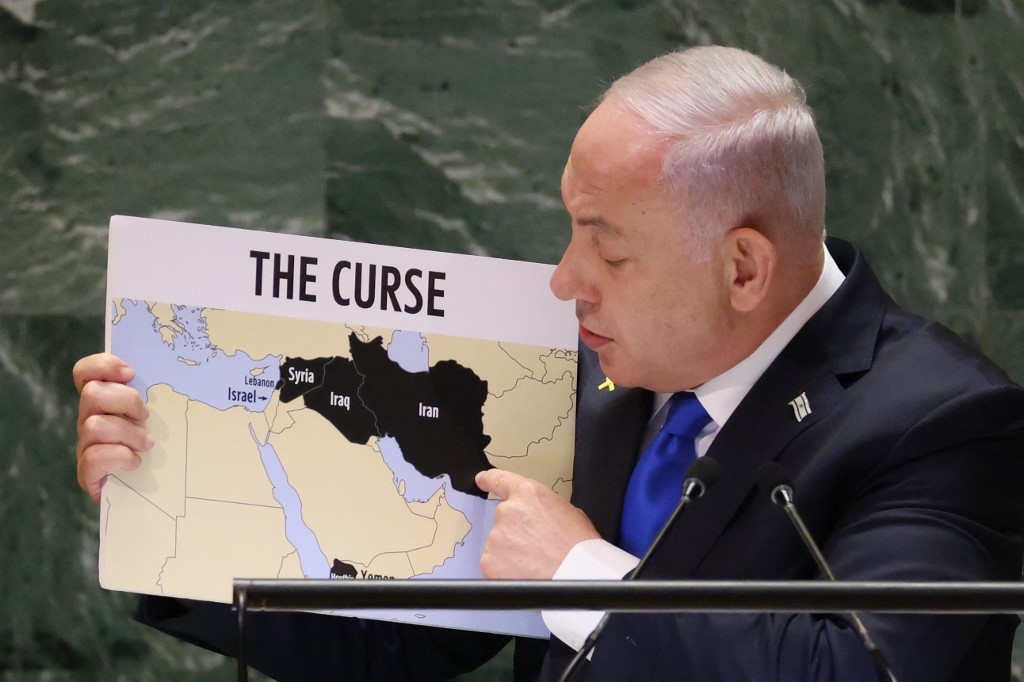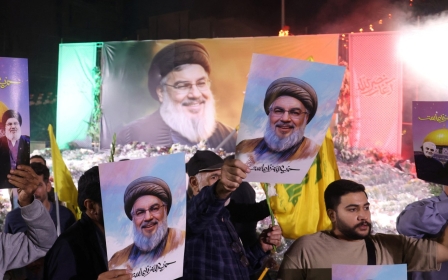Netanyahu’s dream was a US war with Iran. It is now Israel's nightmare

By rights, this should be a moment of sweet joy for Israeli Prime Minister Benjamin Netanyahu. The work of 40 years is finally coming to fruition: the goal of “destroying” all the Middle East “terror states” is close at hand.
Netanyahu has followed a single strategy for around 40 years, outlined in a book he wrote in 1986 called Terrorism: How the West Can Win (currently £143 or $187 on Amazon UK).
In it, Netanyahu defined terrorism as the "deliberate and systematic murder, maiming, and menacing of the innocent to inspire fear for political ends” - a pretty accurate description of what Israel has done in Gaza for the last year and is now doing to Lebanon.
Netanyahu’s theory of “fighting terror” relies, first and foremost, on the use of force. As he explained in a Congressional hearing in 2002 in the run-up to the US invasion of Iraq: “If you take out Saddam, Saddam’s regime, I guarantee you it will have enormous positive reverberations on the region.”
Less than entirely convinced of Netanyahu’s faith that regime change would bring a flowering of peace and stability across the region, Representative John Tierney, a more critical voice than you are likely to hear in the sycophantic Congress of today, responded: “Is that speculation on your part or do you have some evidence?”
New MEE newsletter: Jerusalem Dispatch
Sign up to get the latest insights and analysis on Israel-Palestine, alongside Turkey Unpacked and other MEE newsletters
Netanyahu was unfazed: “I was asked the same question in 1986. I had written a book in which I said the way to deal with terrorist regimes, with terror, was to apply military force against them.”
“The way we did in Afghanistan?” responded Tierney.
Discounting fears that the Nato Afghan invasion would draw in jihadist fighters from across the world, the then-Israeli foreign minister replied: “What we saw was something else...First of all, we saw everybody streaming out of Afghanistan; the second thing we saw was many Arab countries, Muslim countries trying to side with America, trying to be OK with America.”
Afghanistan became a 20-year war that ended in failure. However, Netanyahu’s comments about the Arab states were not entirely without merit. The more the Israelis and the Americans tore through the Middle East, from Iraq to Lebanon, Libya and Syria, the more the remaining pro-western Arab states drew closer to the US and Israel.
Invasions and implosions
It is worth repeating what Netanyahu said before the bloodshed and misery of the Iraq invasion unfolded to appreciate the way his mind works: as a glorified real estate speculator who wants to acquire as much land as possible by any means possible.
“The application of power is the most important thing in winning the war on terrorism [for "terrorism", read resistance to Israeli annexation and US imperialism]. It’s like what are the three principles of real estate, the three Ls: location, location, location. The three principles of winning the war on terror are the three Ws: winning, winning and winning. The more victories you amass, the easier the next victory becomes.
"The first victory in Afghanistan makes the next victory in Iraq that much easier. The second victory in Iraq will make the third victory that much easier, but it may change the nature of winning that victory. It may be possible to have implosions taking place. I don’t guarantee it, Mr Tierney, but I think it makes it more likely.”
As it turned out, following the disastrous invasion of Iraq and later Lebanon, there were “implosions” across the whole region in 2011. These were not without risks for Israel, but the counter-revolutions that ended the uprisings ensured that no destabilising force would threaten Netanyahu’s vision of a reconfigured Middle East.
In fact, the post-2011 order was more pro-Israel than the one that preceded it. This strategy culminated in the 2020 normalisation accords with four Arab states, implemented without any concessions on Palestinian demands for self-determination.
Then, things fell apart.
Gates of hell
Netanyahu’s strategy of containing the Palestinian issue by besieging Gaza and co-opting the Palestinian Authority into a gradual colonisation of the West Bank, while seeking normalisation deals with Arab states, ended on 7 October. Since 8 October, following the Hamas-led attacks, Netanyahu and his allies have adopted a policy of all-out war against the Palestinians and accelerated colonisation in the occupied territories.
With the recent assassination of Hassan Nasrallah, Netanyahu has opened the gates of hell. Having killed the Hezbollah leader in such a brazen, reckless manner, using dozens of 1-tonne US bombs to destroy a whole block, and also killing a senior Iranian leader in the same strike, an Iranian response was only a matter of time.
Netanyahu still has his one trump card: the United States and its limitless supply of weapons and diplomatic cover
According to Lebanese Foreign Minister Abdallah Bou Habib, Nasrallah had agreed to a ceasefire just before his assassination, with the Lebanese government informing the US and France, who, in turn, said that Netanyahu had agreed to the plan.
This was a lie. The Iranian supreme leader had warned Nasrallah days before his death that the Israelis were planning to kill him and urged him to flee to Iran.
Speaking before the UN last week, on the day he gave the go-ahead for the strike on Nasrallah, Netanyahu told the gathered UN members that the global body was “a swamp of antisemitic bile”, “a house of darkness” and home turf for the Palestinians.
“We are winning,” he bombastically declared as delegates filed out in disgust, leaving a largely empty hall. The strategy of “win, win, win” was looking less effective than he had claimed 22 years earlier. This was perhaps because after a year of total devastation and tens of thousands killed, Israel was not even decisively victorious in Gaza.
This was the same venue where he had sat as ambassador 40 years earlier, when Palestine had no seat. But since June 2024, it has been a full member of the UN, recognised as a sovereign state by 146 of the 193 member states. The General Assembly passed a resolution last month demanding an end to Israel’s occupation of Palestine within the next 12 months by an overwhelming margin. The International Court of Justice (ICJ) ruled the same in July. Israel has run out of time.
Netanyahu still has his one trump card: the United States and its limitless supply of weapons and diplomatic cover. As Israeli analyst Ori Goldberg puts it, for Israel, the rest of the world does not exist, only Israel does. It is one, plus the US and a handful of allies, versus the whole world.
"There is no place that the long arm of Israel cannot reach," Netanyahu said after comparing Israel’s seven-front war to the conquest Moses instructed his people to wage as they entered Canaan from the plains of Moab. The seven fronts he identified with his cartoon maps were Gaza, Judea and Samaria (occupied West Bank), Lebanon, Yemen, Iraq, Syria and Iran. Israel is at war with half of the Middle East.
Crossing the Rubicon
Where are all the Muslim and Arab countries that Netanyahu promised 22 years ago would be eager to side with America and Israel as they wage war against all these enemies? Even favourites such as the UAE, Saudi Arabia and Bahrain have been decidedly wary of being seen as too close to Israel as it destroys Gaza and rampages into Lebanon.
Perhaps this is just a blip, and once Netanyahu chalks up another “victory”, they will file back into line. But that victory is not assured. The early days of the Lebanon war suggest that the decapitation strategy has not degraded Hezbollah's capacity to inflict lethal damage and retreat on Israeli forces. The quagmire of Lebanon could yet swallow up Netanyahu’s dreams.
For Netanyahu, the gambler, a full-scale Middle East war is the last roll of the dice
And then there is Iran. Netanyahu is closer than ever to his long-cherished dream of a regional war between Iran and the US. This should be his moment of triumph. With its display of brute power in Gaza, Lebanon and Tehran (with the assassination of Ismail Haniyeh in July) having shocked and awed the region and world, surely now is the time of victory?
Iran, with its 180 missiles raining down on Tel Aviv and striking military bases in a targeted assault, has shown that it can strike back. The absence of civilian casualties was seen through the lens of Israel’s genocidal war strategy as a failure, but it was surely intentional.
Just a day after Iran’s missile attack, Saudi Arabia’s foreign minister, Prince Faisal bin Farhan, met with Iran’s president in Doha and said: “We intend to close the book on disagreements with Iran forever.” This is not the “new Middle East” that Netanyahu has worked so long for. This is Israel’s nightmare. The emptiness of Israel’s military power (no matter how many people it kills), and the full reality of its isolation are now clear for all to see.
For Netanyahu, the gambler, a full-scale Middle East war is the last roll of the dice. A Rubicon has been crossed since Nasrallah's killing. But Netanyahu is no Julius Caesar and the Litani River may still be Israel’s undoing.
Middle East Eye delivers independent and unrivalled coverage and analysis of the Middle East, North Africa and beyond. To learn more about republishing this content and the associated fees, please fill out this form. More about MEE can be found here.







